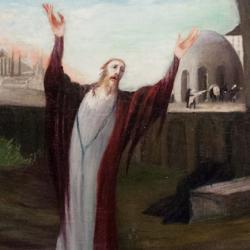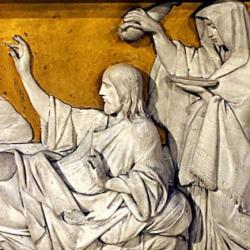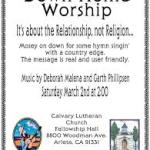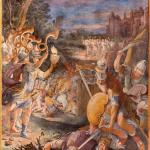Daniel Olson ( CBQ 2005) revives JM Duncan Derrett’s suggestion that the parable of the wedding feast in Matthew 22:1-14 is dependent on the LXX of Zephaniah 1. After offering a translation of both passages in parallel, showing verbal links, he adds:
“In addition to these highlighted correspondences . . . there are two parallels in ideas but not language that call for special comment: f onei—apoktenouvntoi (Matt 22:7; Zeph 1:10) and fimoo—eulambano (Matt 22:12; Zeph 1:7). Hebrew hrg (“slay”), which the LXX apparently found in its Vorlage of Zeph 1:10 . . . is translated by both apokteivno and foneuo in the LXX, and since Matthew knew both the LXX and Hebrew versions of the Scriptures, Matt 22:7 may reflect the evangelist’s knowledge of a Hebrew text of Zeph 1:7 similar to the Vorlage of the LXX . . .
“The parallel is closer if, as most commentators believe, the reference to vengeance on the ‘murderers’ and ‘their city’ in Matt 22:7 is an allusion to the destruction of Jerusalem in 70 C.E. Zephaniah 1:4 and 10-12 make it clear that the doomed city—full of howling and lamentation, and within which is found the “gate of the killers” (v. 10)—is indeed Jerusalem. Similarly, the silence of the ill-clad guest in Matt 22:12 . . . (“he was silenced”) may reflect Matthew’s awareness of Hebrew hs (“Be silent”) in Zeph 1:7, where the LXX has (“Be afraid”). Again the parallel is close, since the speechless guest in Matthew is not simply silent, but silent ‘before the presence of the Lord God’ (who appears here under the similitude of the parabolic king). In this same category of thematic but not verbal correspondence, some might see a general resemblance between the unconcerned invitees, who go about their business, ‘one to his field, another to his business’ (v. 6), and the equally unconcerned Jerusalemites of Zeph 1:12-13.”
Zephaniah 1:7 is crucial. It says that Yahweh has prepared a sacrifice, invited the people whom He has “sanctified” to come. Matthew, understandably, understands the sacrifice as a feast, specifically a wedding feast, and like Zephaniah speaks of those who are “called” to the feast. Overall, Zephaniah provides a precedent for the sequence of invitation-judgment that is found in Jesus’ parable. Zephaniah’s emphasis on the need for “sanctification” is picked up in Jesus’ comment that the initial invitees were not “worthy,” and in the expulsion of the guest with inappropriate clothing. Most strikingly, Zephaniah 1:8 says (in Olson’s translation) “I will take vengeance on the rulers, and on the king’s house, and upon all that are garbed in strange garments.”
Olson says that Matthew leaves out several of Zephaniah’s themes: First, the condemnation of the rich and powerful whose silver and gold can’t deliver them (1:18); second, the condemnation of syncretism and false religion; third, the condemnation of those who “fill the house of their Lord with violence and deceit” (1:9). I think, rather, that these are all being imported. Jesus has already condemned the temple authorities as a bunch of robbers, and treats their hypocrisy as a kind of idolatry. A condemnation of the oppressive rich is implicit in Jesus’ earlier quotation of Jeremiah 7 and His use of the temple for the healing of the blind and lame.
Olson suggests that “the correspondence between Zephaniah 1 and Matt 22:1-14 that potentially explains the motivation for creating a midrashic retelling of the Great Feast in the first place” is “the destruction of Jerusalem described in Zeph 1:9-10 and the consuming of the land by the fire of God’s jealousy in the day of the Lord’s wrath (v. 18) may be important for interpreting Matt 22:7.” After summarizing some of the objections to this interpretation, Olson concludes that Jesus’ parable does in fact refer to the destruction of Jerusalem.











